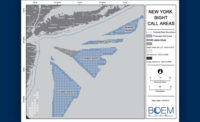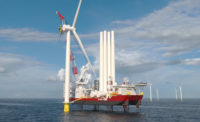Two new joint ventures between U.S. and European developers of offshore wind power are set to pursue projects off California that will require floating platforms in deep coastal water. A third group that also has a European partner was selected by a northern California utility to build a floating offshore wind farm set to generate up to 150 MW off the coast of Eureka, which has some of the strongest winds in the state.
Seattle-based startup Trident Winds, which sparked California’s interest in offshore wind in 2016 when it filed an unsolicited proposal for a large project off Morro Bay, teamed with German utility EnBW on June 8 to build its up-to-1,000-MW project in water as deep as 130 ft. “We’re still hoping to have it on line in the 2026 timeframe, plus or minus,” Trident founder Alla Weinstein told ENR, adding that EnBW provides funding and expertise to the joint venture.
Related Link
New England Bets Big on Offshore Wind Power
Separately, Magellan Wind and Copenhagen Infrastructure Partners (CIP) will pursue an early stage development portfolio of floating offshore wind projects in California and in other U.S. areas, says Jim Lanard, Magellan CEO. “We expect floating wind to be a significant contributor to this … sustainable industry,” he says. CIP is half-owner of Vineyard Wind, chosen by Massachusetts last month to build 800 MW offshore. Among senior advisors to Magellan is Henrik Stiesdal, former Siemens Wind Power chief technology officer and inventor of the TetraSpar floating wind turbine foundation.
Weinstein also founded Principle Power, a floating wind technology firm that is developing offshore projects in a consortium selected in April through a public-private partnership with the Redwood Coast Energy Authority. The team was one of six respondents to the utility’s request for qualifications. “We believe this project can represent a game changer for the industry in the U.S.,” says Joao Metelo, Principle Power CEO. In a statement, the authority cited the team’s mature, cost-competitive floating wind technology and its capacity to develop, finance, operate and build a project and build a supply chain for future ones.
The U.S. National Renewable Energy Lab estimates there is more than 800 GW of energy potential available for floating offshore wind technologies off the West Coast.






Post a comment to this article
Report Abusive Comment